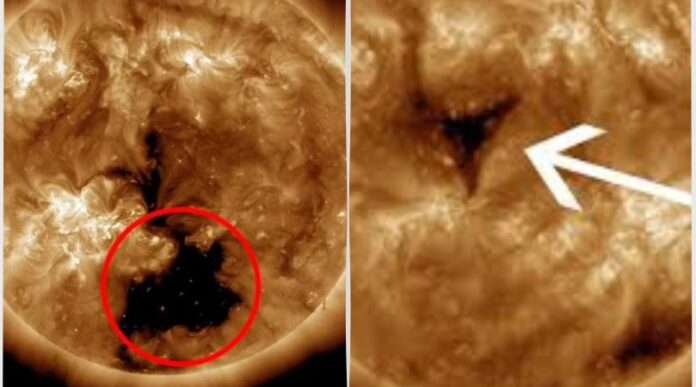Shillong:
National Aeronautics and Space Administration (NASA) scientists on March 23 have discovered a massive coronal hole on the Sun, that is causing solar wind to be ejected towards the Earth. This exciting discovery is prompting worldwide attention, as people are curious to know what the impact of the coronal hole will be on our planet.
Coronal holes are areas on the Sun’s surface where the magnetic fields open up and allow hot gases to escape into space. This stream of solar wind could hit Earth on March 31 and can cause disturbances in the Earth’s magnetic field, resulting in geomagnetic storms, which can interfere with power grids, communication networks, and even harm satellites orbiting the Earth.
Although coronal holes are relatively common occurrences, the size and position of the one currently facing Earth are of great concern, given that it is one of the largest coronal holes ever observed. The coronal hole is estimated to be over 1.7 million kilometres wide, which is about 20 times larger than the size of the Earth.
Scientists predict that the impact of the coronal hole’s solar wind could cause fluctuations in GPS navigation systems, as well as affecting airlines’ communication and navigation systems. It could also cause auroras to be visible further south than usual, creating spectacular light shows visible to those in the Northern Hemisphere.
NASA’s Solar Dynamics Observatory (SDO) is closely monitoring the Sun’s activity and will provide updates on any potential impacts of the coronal hole on Earth. Although it is too early to predict the exact nature of the impact, scientists are taking all necessary precautions to make sure that we are safe.
Despite the potential risks, the coronal hole is also providing valuable data for NASA and other space agencies, as the scientific community continues to study the impact of solar weather on the Earth’s environment.
In conclusion, NASA’s discovery of the coronal hole on the Sun is a reminder of the impact of seemingly distant cosmic events on our planet. As we continue to study the universe around us, we are gaining a better understanding of the complex systems at play, and taking necessary steps to protect ourselves from the effects of solar weather.


